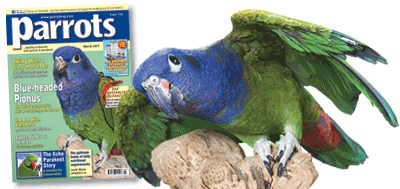
Buy your copy now!
Save money if you subscribe - 12 issues for the price of 11
In this issue...
- Have we built a cage, a flight, or an aviary? - read more
- Optimal levels of nutritional daily requirements - read more
- The Australian Outback - read more
- The sweet-natured Blue-headed Parrot - read more
- The Echo Parakeet - read more
- Living with an African Grey - read more
- Seeing red over mite infestations - read more
- News, Bird Alert, Readers Story, FREE classified advertising and a full listing of Avian Vets

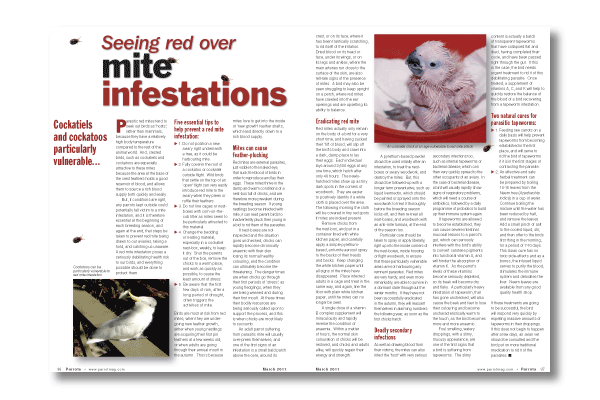
Parasitic red mites tend to seek out birds as ‘hosts,’ rather than mammals, because they have a relatively high body temperature compared to the rest of the animal world. And, crested birds, such as cockatiels and cockatoos are especially attractive to these mites because the area at the base of the crest feathers holds a good reservoir of blood, and allows them to source a rich blood supply both quickly and easily.
But, if conditions are right, any parrots kept outside could potentially fall victim to a mite infestation, and it is therefore essential at the beginning of each breeding season, and again at the end, that steps be taken to prevent red mite being drawn to our aviaries, taking a hold, and catching us unaware. A red mite infestation poses a seriously debilitating health risk to our birds, and everything possible should be done to protect them.
Read more in the magazine…
Buy a copy now!
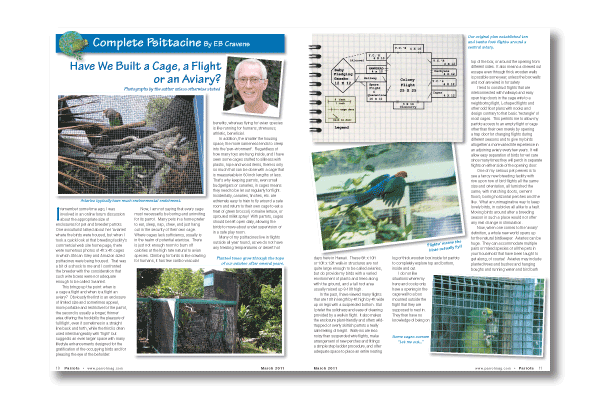
Have We Built a Cage, a Flight or an Aviary?
I remember some time ago, I was involved in an online forum discussion about the appropriate size of enclosures for pet and breeder parrots. One aviculturist talked about her ‘aviaries’ where the birds were housed, but when I took a quick look at that breeding facility’s commercial web site home page, there were numerous photos of 4ft x 4ft cages in which African Grey and Amazon sized psittacines were being housed. That was a bit of a shock to me and I confronted the breeder with the consideration that such wire boxes were not adequate enough to be called ‘aviaries’.
This brings up the point: when is a cage a flight and when is a flight an aviary? Obviously the first is an enclosure of limited size and sometimes appeal, more portable and restrictive for the parrot, the second is usually a longer, thinner area offering the hookbills the pleasure of full flight, even if sometimes in a straight line back and forth, while the third is often used interchangeably with ‘flight’ but suggests an even larger space with many lifestyle enhancements designed for the gratification of the occupying birds and for pleasing the eye of the beholder.
Read more in the magazine…
Buy a copy now!
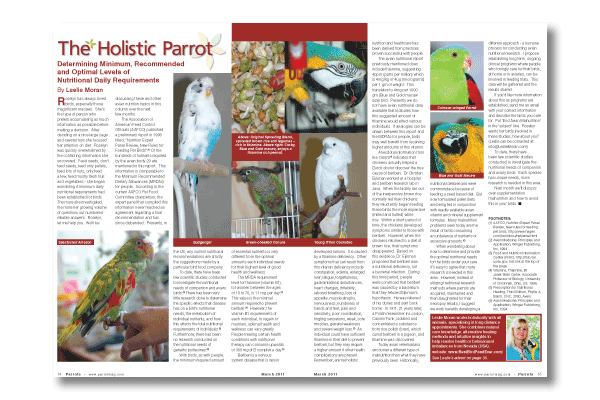
Determining Minimum, Recommended and Optimal Levels of Nutritional Daily Requirements
Roselyn has always loved birds, especially those magnificent macaws. She’s the type of person who prefers accumulating as much information as possible before making a decision. After deciding on a nice large cage and several toys she focused her attention on diet. Roselyn was quickly overwhelmed by the conflicting information she uncovered. Feed seeds, don’t feed seeds, feed only pellets, feed lots of nuts, only feed a few, feed mostly fresh fruit and vegetables - she began wondering if minimum daily nutritional requirements had been established for birds. The more she investigated, the more her growing volume of questions out numbered reliable answers. Roselyn, let me help you. We’ll be discussing these and other avian nutrition topics in this column over the next few months.
The Association of American Feed Control Officials (AAFCO) published a preliminary report in 1998 titled, “Nutrition Expert Panel Review, New Rules for Feeding Pet Birds”. Of the hundreds of nutrients required by the avian body 29 are mentioned in this report. This information is comparable to the Minimum Recommended Dietary Allowances (MRDAs) for people. According to the current AAFCO Pet Food Committee chairperson, the expert panel that compiled this information never reached an agreement regarding a final recommendation and has since disbanded. Presently, in the US, any current nutritional recommendations are strictly the suggestions made by a particular bird food company.
Read more in the magazine…
Buy a copy now!

by Robert Alison
Australia’s Outback, normally dry, barren and uninviting, has been transformed into a lush semi-paradise by extraordinary rains that persisted in much of 2010. This fortunate development was responsible for a major breeding initiative in all species of local psittacids, many of which had refrained from nesting, or had relocated to more hospitable areas, as a result of a decade of devastating drought.
According to officials at the Alice Springs (Northern Territory) Desert Wildlife Park, although the area had suffered through exceptional drought for 10 years, 2006 was the driest year of all, with much of the Outback receiving only about 70 mm of precipitation. But, rains that began in February 2010, and continued fairly regularly afterwards, achieved a remarkable landscape transformation. In some areas, up to 800 mm of rain fell over an 11 month period and local flooding was widespread.
Much of the Outback metamorphosed into a luxuriant kaleidoscope of flowers, fruit-laden trees and flowering shrubs, as well as thick froths of succulent grasses, especially seed-heavy buffel grasses so desirable to some psittacids. “It has been quite unusual, and much of the region has become extraordinarily green,” confirmed a ranger at Ormiston Gorge National Park in the West MacDonnell Range, Northern Territory.
Read more in the magazine…
Buy a copy now!
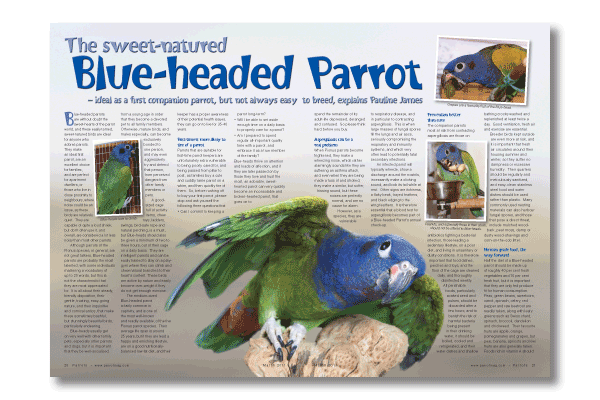
– ideal as a first companion parrot, but not always easy to breed, explains Pauline James
Blue-headed parrots are without doubt the sweet-hearts of the parrot world, and these easily tamed, sweet-natured birds are ideal for anyone who adores parrots. They make an ideal first parrot, are an excellent choice for families, and are perfect for apartment dwellers, or those who live in close proximity to neighbours, where noise could be an issue, as these birds are relatively quiet. They are capable of quite a loud shriek, but don’t often use it, and overall, are considered a lot less noisy than most other parrots.
Although parrots of the Pionus species, in general, are not great talkers, Blue-headed parrots are probably the most talented, with some individuals mastering a vocabulary of up to 20 words, but this is not the characteristic that they are most appreciated for. It is all about their steady, friendly disposition, their gentle, trusting, easy-going nature, and their inquisitive and comical antics, that make these sometimes bashful, but stunningly beautiful birds, particularly endearing.
Blue-heads usually get on very well with other family pets, especially other parrots and dogs, but it is important that they be well-socialised from a young age in order that they become a devoted pet to all family members. Otherwise, mature birds, and males especially, can become exclusively bonded to one person, and may even aggressively try and defend that person, from perceived dangers from other family members or pets.
Read more in the magazine…
Buy a copy now!







